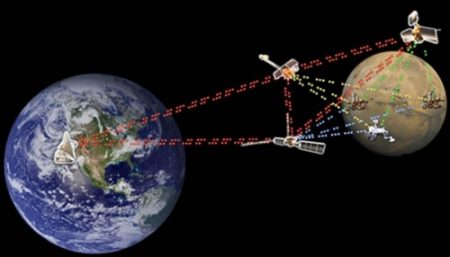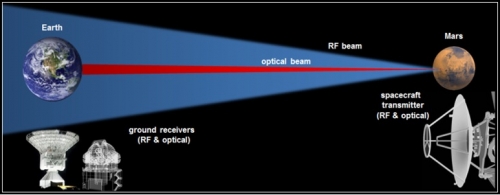November 2, 2016 – The Deep Space network deployed by NASA today uses radio frequency technology to send and receive data from spacecraft circling Saturn, Jupiter, Mars, Mercury, our Moon, the Sun, Ceres and beyond Pluto. But radio frequency systems have limitations, particularly in the amount of data and the speed of transmission from Deep Space.
For example after New Horizons rendezvoused with Pluto in the summer of 2015 it took until October 25th of this year for the 6.25 Gigabytes of data collected to be transmitted over a distance of 5 billion kilometers to receiving stations here on Earth. The total number of Earth days measured 469. Every instruction to New Horizons had to be planned eight weeks in advance of sending the code to the spacecraft. Communications were relayed through the Deep Space Network’s 70-meter radio telescope in Canberra, Australia. On average the amount of time the New Horizons mission could book on the telescope was about 8 hours per day. Each Pluto image took 42 minutes to get to Earth. That meant 11 images could be captured per session. The on board memory storage captured data from seven different instruments including cameras, particle sniffers, dust collectors and more. At any time a glitch could have destroyed the incredible data that New Horizons captured as it sped by the Plutonian system recording its amazing treasure of pictures and information. And we had to wait a few days to see the first images, and then many more weeks to see and learn even more. There has to be a better way. And NASA believes it has it.
NASA wants to use lasers and calls the field photonics. Its initial research indicates using light to communicate can increase data rates by a factor of 100. It means faster transmissions and more data rich communication. For example, with laser communication we could see live video feeds from a spacecraft circling Europa, or a rover on the Martian surface.
In 2013, NASA launched its first laser communication system to the vicinity of the Moon in a test to see if it was a viable technology. The mission malfunctioned when a navigation maneuver resulted in the spacecraft crashing on the lunar surface. Now NASA plans a second mission, the Laser Communications Relay Demonstration (LCRD) scheduled for launch in 2019. Using the International Space Station, a remote test satellite and two Earth ground stations, LCRD should work out the kinks in using lasers to communicate in space.
The real goal however is not near-Earth but in Deep Space. Laser communication can be inserted into spacecraft and robotic landers with a form factor a fraction the size of radio frequency communicators. With lasers and a few relay way stations placed strategically between Earth and Mars we could have the first high-speed long distance communication network to connect the two planets.
NASA and its partnering academic and research facilities are in the process of developing a hybrid communication technology that incorporates both laser and radio frequency. The goal is to be able to communicate with all legacy systems as well as any new robotic and human-occupied spacecraft launched in the near future. The design specification for the technology aims at 40 times improvement in data speed and bandwidth rates using laser, and 16 times improvement using radio frequency.

















